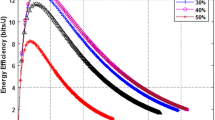Abstract
In cooperative cognitive radio networks (CCRN), Primary Users (PUs) share their unused spectrum resources with Secondary Users in order to facilitate cooperative communication in cognitive radio networks (SUs). The novel hybrid Giza Pyramids construction-based Complex valued Satin Bower Optimization (GPC-CSBO) algorithm is proposed in this paper to tackle the multiobjective resource allocation problem in CCRN. To operate the cooperative intermediate nodes and increase their throughput, a variety of constraints are taken into consideration, including the amount of power transmitted, QoS constraints, channel capacity, energy consumption, the priority of resource requests from secondary users (SUs), throughput, fairness evaluation constraints, etc. By constructing a cluster of SUs with the help of the SU base station, the GPC algorithm is used for effective load balancing. By providing 11 different constraints as an input to the hybrid GPC-CSBO algorithm, the SUs message request is prioritized and queued. The hybrid GPC-CSBO algorithm selects an optimal path between the SU to the PU base station based on fairness. The efficiency of the proposed algorithm is evaluated in an IEEE 802.11 WLAN area by comparing the proposed methodology with existing techniques. Throughput, energy efficiency, fairness index, delay, packet delivery, and network lifetime are taken into consideration when determining how effective the proposed approach is.










Similar content being viewed by others
Availability of data and material
Data sharing is not applicable to this article as no new data were created or analyzed in this study.
Code availability
Not applicable.
References
Das GC, Saha S, Bhowmick A, Maity SP (2020) Throughput analysis of a energy harvesting cooperative cognitive radio network. In: 2020 XXXIIIrd General Assembly and Scientific Symposium of the International Union of Radio Science (pp. 1–4). IEEE
Ostovar A, Keshavarz H, Quan Z (2021) Cognitive radio networks for green wireless communications: an overview. Telecommun Syst 76(1):129–138
Maharaj BT, Awoyemi BS (2022) Introduction to cognitive radio networks. In: Maharaj BT, Awoyemi BS (eds) Developments in cognitive radio networks. Springer, Cham
Rajpoot V, Tripathi V (2022) Cross-layer design based hybrid MAC protocol for cognitive radio network. Phys Commun 50:101524
Zhou X, Li Y, Kwon YH, Soong AC (2008) Detection timing and channel selection for periodic spectrum sensing in cognitive radio. In: IEEE GLOBECOM 2008–2008 IEEE Global Telecommunications Conference (pp. 1–5). IEEE
GHOSH S, Maity SP, Acharya T (2021) On outage analysis in overlay CCRN with RF energy harvesting and co-channel interference
Naeem A, Rehmani M, Saleem Y, Rashid I, Crespi N (2017) Network coding in cognitive radio networks: a comprehensive survey. IEEE Commun Surv Tutor 19(3):1945–1973
Liang YC, Zeng Y, Peh EC, Hoang AT (2008) Sensing-throughput tradeoff for cognitive radio networks. IEEE Trans Wireless Commun 7(4):1326–1337
Sundararaj V (2016) An efficient threshold prediction scheme for wavelet based ECG signal noise reduction using variable step size firefly algorithm. Int J Intell Eng Syst 9(3):117–126
Sundararaj V (2019) Optimal task assignment in mobile cloud computing by queue based ant-bee algorithm. Wireless Personal Commun 104(1):173–197
Justus JJ, Anuradha M (2022) A golden eagle optimized hybrid multilayer perceptron convolutional neural network architecture‐based three-stage mechanism for multiuser cognitive radio network. Int J Commun Syst 35(4):e5054
Zheng G, Ho Z, Jorswieck EA, Ottersten B (2014) Information and energy cooperation in cognitive radio networks. IEEE Trans Signal Process 62(9):2290–2303
Gwon Y, Dastangoo S, Kung HT (2013) Optimizing media access strategy for competing cognitive radio networks. In: 2013 IEEE Global Communications Conference (GLOBECOM) (pp. 1215–1220). IEEE
Preetham CS, Prasad MSG (2016) Hybrid overlay/underlay transmission scheme with optimal resource allocation for primary user throughput maximization in cooperative cognitive radio networks. Wireless Pers Commun 91(3):1123–1136
Zhang G, Yang K, Song J, Li Y (2013) Fair and efficient spectrum splitting for unlicensed secondary users in cooperative cognitive radio networks. Wireless Personal Commun 71(1):299–316
Kaur A, Kumar K (2020) Energy-efficient resource allocation in cognitive radio networks under cooperative multi-agent model-free reinforcement learning schemes. IEEE Trans Netw Serv Manag 17(3):1337–1348
Liao X, Si J, Shi J, Li Z, Ding H (2020) Generative adversarial network assisted power allocation for cooperative cognitive covert communication system. IEEE Commun Lett 24(7):1463–1467
Peter G, Livin J, Sherine A (2021) Hybrid optimization algorithm based optimal resource allocation for cooperative cognitive radio network. Array 12:100093
Song Z, Wang X, LiuZhang YZ (2019) Joint spectrum resource allocation in NOMA-based cognitive radio network with SWIPT. IEEE Access 7:89594–89603
Liu Z, Zhao S, Yuan Y, Yang Y, Guan X (2021) Game-based approach of fair resource allocation in wireless powered cooperative cognitive radio networks. AEU-Int J Electron Commun 134:153699
Harifi S, Mohammadzadeh J, Khalilian M, Ebrahimnejad S (2020) Giza pyramids construction: an ancient-inspired metaheuristic algorithm for optimization. Evolut Intell 14:1743
Zhang S, Zhou Y, Luo Q (2021) A complex-valued encoding satin bowerbird optimization algorithm for global optimization. Evol Syst 12(1):191–205
Zhang Y, Jin Z, Chen Y (2020) Hybrid teaching–learning-based optimization and neural network algorithm for engineering design optimization problems. Knowl-Based Syst 187:104836
Wang P, Zhou Y, Luo Q, Han C, Niu Y, Lei M (2020) Complex-valued encoding metaheuristic optimization algorithm: a comprehensive survey. Neurocomputing 407:313–342
Funding
Not applicable.
Author information
Authors and Affiliations
Corresponding author
Ethics declarations
Conflict of interest
The authors declare that they have no conflict of interest.
Consent to participate
Not applicable.
Consent for publication
Not applicable.
Human and animal rights
This article does not contain any studies with human or animal subjects performed by any of the authors.
Informed consent
Informed consent was obtained from all individual participants included in the study.
Additional information
Publisher's Note
Springer Nature remains neutral with regard to jurisdictional claims in published maps and institutional affiliations.
Rights and permissions
Springer Nature or its licensor holds exclusive rights to this article under a publishing agreement with the author(s) or other rightsholder(s); author self-archiving of the accepted manuscript version of this article is solely governed by the terms of such publishing agreement and applicable law.
About this article
Cite this article
Justus, J.J., Anuradha, M. Resource allocation scheme for CCRN using hybrid Giza Pyramids construction-based complex-valued satin bowerbird optimization. J Supercomput 79, 4687–4712 (2023). https://doi.org/10.1007/s11227-022-04761-4
Accepted:
Published:
Issue Date:
DOI: https://doi.org/10.1007/s11227-022-04761-4




